Linfoot Surname Ancestry ResultsOur indexes 1000-1999 include entries for the spelling 'linfoot'. In the period you have requested, we have the following 57 records (displaying 1 to 10): Single Surname Subscription | | | Buying all 57 results of this search individually would cost £312.00. But you can have free access to all 57 records for a year, to view, to save and print, for £100. Save £212.00. More... |
These sample scans are from the original record. You will get scans of the full pages or articles where the surname you searched for has been found. Your web browser may prevent the sample windows from opening; in this case please change your browser settings to allow pop-up windows from this site.  Apprentices registered at York
(1717-1719) Apprentices registered at York
(1717-1719)
Apprenticeship indentures and clerks' articles were subject to a 6d or 12d per pound stamp duty: the registers of the payments usually give the master's trade, address, and occupation, and the apprentice's father's name and address, as well as details of the date and length of the apprenticeship. There are central registers for collections of the stamp duty in London, as well as returns from collectors in the provinces. These collectors generally received duty just from their own county, but sometimes from further afield. Because of the delay before some collectors made their returns, this register includes indentures and articles from as early as 1716. (The sample entry shown on this scan is taken from a Norfolk return)LINFOOT. Cost: £8.00.  | Sample scan, click to enlarge

|  Apprentices registered at York
(1728-1731) Apprentices registered at York
(1728-1731)
Apprenticeship indentures and clerks' articles were subject to a 6d or 12d per pound stamp duty: the registers of the payments usually give the master's trade, address, and occupation, and the apprentice's father's name and address, as well as details of the date and length of the apprenticeship. There are central registers for collections of the stamp duty in London, as well as returns from collectors in the provinces. These collectors generally received duty just from their own county, but sometimes from further afield. (The sample entry shown on this scan is taken from a Norfolk return)LINFOOT. Cost: £8.00.  | Sample scan, click to enlarge

| Inhabitants of Leeds in the West Riding of Yorkshire
(1790-1797)
The provincial sections of the Universal British Directory include lists of gentry and traders from each town and the surrounding countryside, with names of local surgeons, lawyers, postmasters, carriers, &c. (the sample scan here is from the section for Hull). The directory started publication in 1791, but was not completed for some years, and the provincial lists, sent in by local agents, can date back as early as 1790 and as late as 1797.
LINFOOT. Cost: £6.00.  | Sample scan, click to enlarge
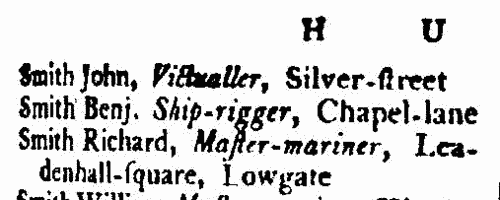
| Inhabitants of Dublin
(1805)
Holden's Triennial Directory of 1805 to 1807 included a provincial section, listing professional people and traders in England, Wales, Scotland and Ireland. (The sample scan here is from the listing for Bath)LINFOOT. Cost: £6.00.  | Sample scan, click to enlarge
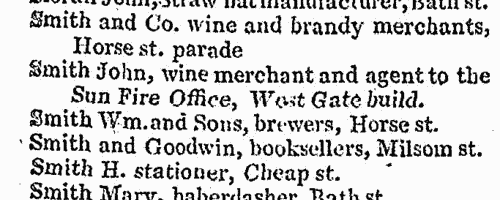
| Deaths, Marriages, Bankrupts, Dividends and Patents
(1820-1821)
Death notices and obituaries, marriage and birth notices, bankrupts and dividends, and patents, as reported in the Monthly Magazine or British Register. Includes some marriages and deaths from Ireland, Scotland and abroad.
LINFOOT. Cost: £6.00.  | Sample scan, click to enlarge

| Merchants and Traders in Dublin (1830)
Wilson's Dublin Directory for the year 1830 lists merchants and traders alphabetically by surname, with christian name or initials, trade, and (in italics) address.
LINFOOT. Cost: £8.00.  | Sample scan, click to enlarge

| Boys entering Leeds Grammar School
(1841)
The admission books for Leeds Grammar School from 1820 to 1900 were edited by Edmund Wilson and published in 1906. The series of registers is almost complete for the period, there being in addition admission registers for the Lower (or Commercial) Department from 1856 to 1865, and lists of boys in the school in 1856, and in the Commercial Department in 1861. The entries are arranged by date or term of admission: a sequential number is given first, then surname, christian name, and, after a dash, father's christian name, occupation, and address; another dash, and then the age of the boy at admission, and often his year of leaving (with the abbreviation r. for 'removed' or 'left'). r.* means left without notice; (o) or S. or Stranger or Foreigner indicates a boy not on the foundation. The editor was unable to divine the meaning of the abbreviation (Q) or the asterisks prefixed to most entries in 1856 to 1860, but dutifully copies them into the text. In smaller type he then proceeds, where possible, to add some information about the boy's subsequent career.LINFOOT. Cost: £4.00.  | Sample scan, click to enlarge
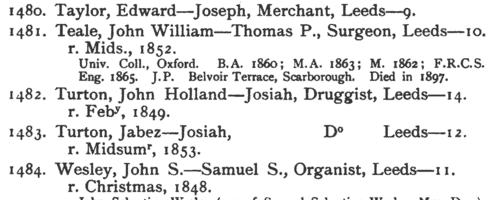
| Inhabitants of Derby
(1842)
Stephen Glover's directory of Derby gives names, trades (in the case of journeymen prefixed with a J.), and addresses: and the list is annotated with the letters F for freeholder, B for burgess, and Fr for freeman.
LINFOOT. Cost: £4.00.  | Sample scan, click to enlarge
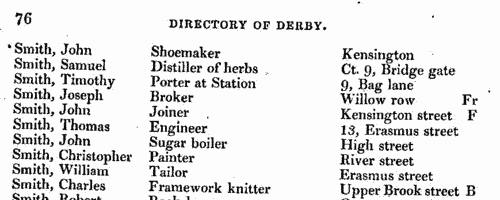
| Insolvents in Bankruptcy
(1843)
Insolvency in bankruptcy notices for England and Wales: insolvency often caused people to restart their lives elsewhere, so these are an important source for lost linksLINFOOT. Cost: £6.00.  | Sample scan, click to enlarge

| Boys entering Leeds Grammar School
(1844)
The admission books for Leeds Grammar School from 1820 to 1900 were edited by Edmund Wilson and published in 1906. The series of registers is almost complete for the period, there being in addition admission registers for the Lower (or Commercial) Department from 1856 to 1865, and lists of boys in the school in 1856, and in the Commercial Department in 1861. The entries are arranged by date or term of admission: a sequential number is given first, then surname, christian name, and, after a dash, father's christian name, occupation, and address; another dash, and then the age of the boy at admission, and often his year of leaving (with the abbreviation r. for 'removed' or 'left'). r.* means left without notice; (o) or S. or Stranger or Foreigner indicates a boy not on the foundation. The editor was unable to divine the meaning of the abbreviation (Q) or the asterisks prefixed to most entries in 1856 to 1860, but dutifully copies them into the text. In smaller type he then proceeds, where possible, to add some information about the boy's subsequent career.LINFOOT. Cost: £4.00.  | Sample scan, click to enlarge
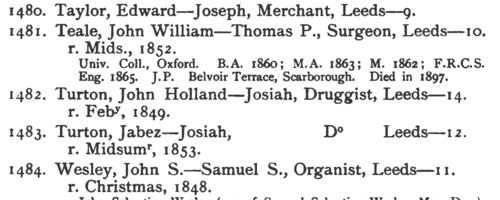
|
Research your ancestry, family history, genealogy and one-name study by direct access to original records and archives indexed by surname.
|













